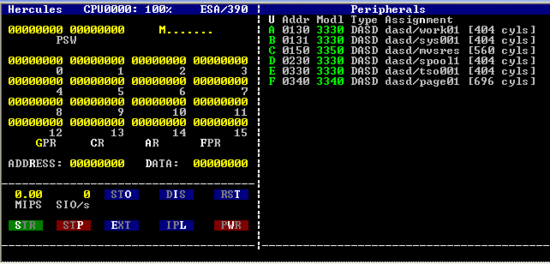Multiple virtual storage
MVS ( M ultiple V irtual S torage) was the most common operating system on the IBM - mainframes System / 370 (S / 370) and System / 390 (S / 390).
History and present
MVS is a descendant of OS / 360 . With the introduction of the S / 370 first OS / VS1 was (or OS / VS MFT, M ultiprogramming with a F ixed number of T asks, similar to DOS / VS and DOS / VSE and advancements to VSE / ESA) delivered , which was further developed in parallel to its later replacement OS / VS2 until the 1980s. Release 1 of OS / VS2 supported a single virtual address space (SVS - Single Virtual Storage) and was also called OS / VS MVT ( M ultiprogramming with a V ariable number of T asks). Release 2 of OS / VS2 was released in July 1974. Its full name was OS / VS2 MVS Release 2 .
In the course of time, the official name of the system was also changed - usually in connection with the change in the hardware architecture. When the S / 370 architecture was changed to S / 370XA (eXtended Architecture - 31-bit instead of 24-bit addressing), the name of the operating system was renamed to MVS / XA. With the introduction of the S / 390 hardware (extension of 31-bit addressing to include dataspaces, hiperspaces, expanded storage) the name was then MVS / ESA (MVS / Enterprise Systems Architecture).
MVS only comprised the pure operating system and could hardly be used without additional product licenses. Data centers had to be licensed to operate a large number of other program products from IBM or alternative providers. In the mid-1990s, IBM changed the licensing policy and the product name from MVS to OS / 390 - this now contained a large number of the program products required by almost everyone (e.g. ISPF ). With the appearance of the z / architecture (64-bit addressing) the system was renamed again and is now called z / OS .
MVS is still in use today in the colloquial language of the mainframe specialists.
particularities
MVS introduced the multiple virtual storage model. The individual applications run in address spaces and do not see the memory of the other applications.
MVS was tailored to the processor architecture of the S / 370. It initially supported 24-bit addressing , which allowed address spaces of 16 megabytes. When hardware made 31-bit addressing possible, this was supported by MVS / XA. Another step was MVS / ESA, which made it possible to use expanded memory (so-called hiperspaces).
The user interfaces of the MVS are essentially the same as those of the z / OS, but without the Unix System Services. In addition to console commands for the operator, these are
- JCL (Job Control Language) for batch processing and started tasks (system services)
- TSO (Time Sharing Option). TSO is typically used with ISPF .
The typical online applications under MVS ran under IMS or CICS and were based on IBM 3270 terminals. From 1983, DB2 was also available as a database.
The file system was taken over by OS / 360. In addition to the existing file types (sequential, partitioned, direct and index-sequential), VSAM was introduced. The individual files are called datasets . EBCDIC is used as character coding instead of the usual ASCII .
Further development
The further evolution to z / OS brought Parallel Sysplex , Unix System Services , 64-bit addressing and other improvements, whereby emphasis was placed on compatibility. On systems under z / OS it is quite possible to run modern Java web applications at the same time as COBOL programs that were compiled in the 1960s.
Versions
| year | month | operating system |
|---|---|---|
| 1964 | April | IBM System / 360 (OS / 360) |
| 1967 | IBM System / 360 (OS / MFT) | |
| 1968 | IBM System / 360 (OS / MVT) | |
| 1972 | IBM System / 370 (SVS1 and SVS2) | |
| 1974 | IBM System / 370 (MVS) | |
| 1981 | IBM System / 370 (MVS / XA) | |
| 1985 | IBM System / 370 (MVS / ESA) | |
| 1990 | IBM System / 390 (MVS / ESA) | |
| 1996 | IBM System / 390 (OS / 390) | |
| 2001 | March | z / OS 1.0 |
| 2003 | Feb | z / OS 1.4 |
| 2004 | March | z / OS 1.5 |
| 2004 | Sept | z / OS 1.6 |
| 2006 | Jan. | z / OS 1.7 |
| 2011 | Sep | z / OS 1.13 |
| 2013 | Sep | z / OS 2.1 |
Emulations
It is possible to run the MVS up to and including version 3.8, which is now available free of charge, on a Windows or Linux computer with the Hercules emulator . Newer versions are not available for this purpose.
Web links
- MVS: the operating system that keeps the world going ( Memento from February 12, 2003 in the Internet Archive )
- Download of MVS from Jay Moseley (format .het, must be converted to DASD via Hercules)
- MVS alternatives at CBTTAPE.ORG
- IBM-PD alternatives and MVS Turnkey 3 at J. Maynard Turnkey 4-
- MVS / 380
- Announcement flyer z / OS V1.13 from IBM (PDF; 86 kB)
